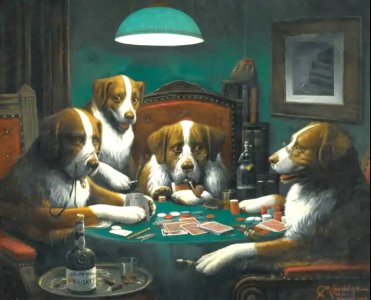Box
Verified SOF
- Joined
- Mar 19, 2018
- Messages
- 2,423
I don't know how to break it to you hucksters, but all things are not as they seem. Take for example the work of Cassius Marcellus Coolidge, the artist known for the “Dogs Playing Poker” paintings...

For decades, the “Dogs Playing Poker” paintings have been celebrated as lighthearted Americana, a whimsical depiction of man’s best friend engaging in human vices. But what if these paintings were more than mere kitsch? What if they were a cryptic exposé of one of the most audacious and bizarre government experiments in history? Recent leaks and whistleblower accounts suggest that these iconic images may be based on real events, part of a covert U.S. government program to develop genetically modified, hyper-intelligent dogs capable of espionage. The implications are staggering, and the cover-up—spanning over a century—may be one of the most elaborate in modern history.
The program’s methods were as unethical as they were ambitious. Early experiments reportedly involved selective breeding of the most intelligent canine breeds—Border Collies, German Shepherds, and Poodles—combined with neurological enhancements through rudimentary brain surgery and chemical stimulants. Later phases introduced genetic manipulation, decades ahead of its time, to amplify cognitive function. The results were said to be astonishing: dogs capable of understanding complex instructions, interpreting human emotions, and even engaging in strategic deception. These were not ordinary pets—they were living, breathing surveillance machines.
Consider the details in the paintings: the intense focus of the dogs, their human-like postures, and the subtle hints of strategy and collusion. In “A Friend in Need,” for example, a bulldog covertly passes an ace to his ally, a move that suggests not just intelligence but an understanding of subterfuge. Could these images be snapshots of real training exercises, disguised as harmless art?
But why go to such lengths to cover up the program? The answer lies in the ethical and geopolitical ramifications. The existence of genetically modified, hyper-intelligent dogs would raise profound questions about the limits of scientific experimentation and the morality of using living beings as tools of espionage. It would also expose the U.S. government to international scrutiny and condemnation, particularly if these dogs had been deployed in covert operations abroad.
...the more you know - and all that jazz.

For decades, the “Dogs Playing Poker” paintings have been celebrated as lighthearted Americana, a whimsical depiction of man’s best friend engaging in human vices. But what if these paintings were more than mere kitsch? What if they were a cryptic exposé of one of the most audacious and bizarre government experiments in history? Recent leaks and whistleblower accounts suggest that these iconic images may be based on real events, part of a covert U.S. government program to develop genetically modified, hyper-intelligent dogs capable of espionage. The implications are staggering, and the cover-up—spanning over a century—may be one of the most elaborate in modern history.
The Origins of Operation Canis
The roots of this conspiracy trace back to the late 19th century, a time of rapid scientific advancement and shadowy government experimentation. Declassified documents from the National Archives reveal the existence of a program codenamed “Operation Canis.” This initiative, allegedly spearheaded by a secretive division of the U.S. War Department, sought to create a new breed of operatives: dogs with enhanced intelligence, problem-solving abilities, and the capacity to mimic human behaviors. The goal was simple but audacious: to create spies that could infiltrate homes, businesses, and even military operations without suspicion.The program’s methods were as unethical as they were ambitious. Early experiments reportedly involved selective breeding of the most intelligent canine breeds—Border Collies, German Shepherds, and Poodles—combined with neurological enhancements through rudimentary brain surgery and chemical stimulants. Later phases introduced genetic manipulation, decades ahead of its time, to amplify cognitive function. The results were said to be astonishing: dogs capable of understanding complex instructions, interpreting human emotions, and even engaging in strategic deception. These were not ordinary pets—they were living, breathing surveillance machines.
The Role of Cassius Marcellus Coolidge
Enter Cassius Marcellus Coolidge, the artist behind the “Dogs Playing Poker” series. Long dismissed as a creator of kitschy, lowbrow art, Coolidge may have been far more than an eccentric painter. Whistleblower accounts suggest that Coolidge had direct knowledge of Operation Canis and used his art to document what he had witnessed. The paintings, with their absurd yet eerily lifelike depictions of dogs engaging in human activities, were likely a form of coded communication—a way to reveal the truth without openly defying the government.Consider the details in the paintings: the intense focus of the dogs, their human-like postures, and the subtle hints of strategy and collusion. In “A Friend in Need,” for example, a bulldog covertly passes an ace to his ally, a move that suggests not just intelligence but an understanding of subterfuge. Could these images be snapshots of real training exercises, disguised as harmless art?
The Cover-Up
The U.S. government’s efforts to suppress the truth about Operation Canis were as thorough as they were effective. Coolidge’s paintings were dismissed as novelty art, their deeper implications ignored by critics and historians alike. Meanwhile, the dogs themselves were quietly phased out of active service. Some were reportedly euthanized to prevent leaks, while others were rehomed as ordinary pets, their extraordinary abilities suppressed through chemical inhibitors.But why go to such lengths to cover up the program? The answer lies in the ethical and geopolitical ramifications. The existence of genetically modified, hyper-intelligent dogs would raise profound questions about the limits of scientific experimentation and the morality of using living beings as tools of espionage. It would also expose the U.S. government to international scrutiny and condemnation, particularly if these dogs had been deployed in covert operations abroad.
The Evidence Mounts
In recent years, a series of leaks has reignited interest in the conspiracy. Former intelligence operatives have come forward with accounts of dogs displaying inexplicable behaviors, such as understanding complex commands in multiple languages or exhibiting uncanny problem-solving skills. Geneticists have also identified anomalies in certain dog breeds that could be remnants of the program’s experiments. Perhaps most compellingly, a cache of photographs from the early 20th century shows dogs in military settings, seated at tables and appearing to "interact" with human handlers in ways that defy explanation.The Implications
If the “Dogs Playing Poker” conspiracy is true, it forces us to reconsider the nature of human-animal relationships and the ethical boundaries of scientific progress. These dogs, bred and trained to serve as tools of espionage, were victims of a program that exploited their loyalty and intelligence. Yet their story also highlights the incredible potential of interspecies collaboration—a potential that, if harnessed ethically, could transform fields ranging from security to therapy.Conclusion
The “Dogs Playing Poker” paintings may no longer be dismissed as mere kitsch. They are artifacts of a hidden history, a glimpse into a world where science, art, and espionage intersect in the most unexpected ways. As researchers and historians continue to uncover the truth about Operation Canis, one thing becomes clear: the story of these superspy dogs is not just about the past—it’s a cautionary tale for the future....the more you know - and all that jazz.
